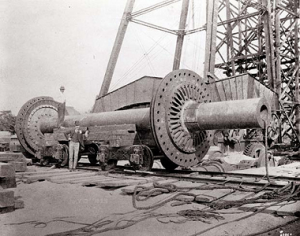 I’ve been curious for some time to find out what the largest metal object in the world is. By “largest metal object in the world”, I mean an object that is formed out of solid metal and is one contiguous piece of homogeneous metal. In other words, search results that yielded things like “largest metal sculpture in the world” don’t count, in my opinion. Additionally, I was looking for something that served an actual purpose, not just something to look at.
I’ve been curious for some time to find out what the largest metal object in the world is. By “largest metal object in the world”, I mean an object that is formed out of solid metal and is one contiguous piece of homogeneous metal. In other words, search results that yielded things like “largest metal sculpture in the world” don’t count, in my opinion. Additionally, I was looking for something that served an actual purpose, not just something to look at.
I still haven’t found a contemporary answer to this question. But that’s because I got sidetracked. Without question, I have learned what the largest piece of cast metal in the world was – back in 1893.
The USA was in a severe depression, marked by the collapse of railroad overbuilding and shaky railroad financing which set off a series of bank failures. Meanwhile, plans were underway to celebrate the 400 year anniversary of Columbus’ discovery of America, in Chicago, and in typical American style, a minor glitch such as the worst depression to date in the US wasn’t going to get in its way. The name of the game called upon civil engineers to build something truly unique that would demonstrate the possibilities of modern engineering in America, similar to what the Eiffel Tower had done for the French.
One man in the audience took to the challenge right away. His name was George Washington Gale Ferris, and his specialty was building steel bridges. Soon to become known as somewhat of a freak (“the Man with the Wheels in his Head”), he had a plan to build a giant wheel that people could sit in, just for fun. And sure enough, in spite of the fact that his idea had no practical value whatsoever (besides making history in the Columbus Fair) and that it required a lot of money, Ferris’ enthusiasm was catching, and he raised the money to make his plan into a reality.
On its completion, Ferris’ Wheel weighed 2,079,884 pounds. The axle alone, forged by Bethlehem Iron Company (later to become Bethlehem Steel), weighed 89,320 pounds. Powered by 2 steam engines, it could carry up to 2160 passengers at one time. It was a colossus; and without question, it was the largest piece of cast metal in the world. Most notably, although it can be argued that it was built for fame and glory, its actual purpose was pure fun.
The Ferris Wheel became a huge overnight sensation, eventually spawning plenty of stories and legends about people falling off the Wheel, etc. Although untrue, these stories took a toll on the Wheel’s popularity, and soon only few people could be seen riding on the Wheel. This wondrous feat of engineering, which had required over $400,000 to build in 1893, was sold at auction in 1906 for $1800. A decision was made to take it down, and on May 11, 1906, the Ferris Wheel was blown to bits by a “monster charge of dynamite”.
George Ferris, the inventor of the Ferris Wheel, didn’t do much better. Similar to many contemporary Hollywood overnight celebrities, he became severely depressed by the looming threat of bankruptcy and his own loss of fame. He died of typhoid fever on November 22, 1896. Saddest of all, his ashes remained at a Pittsburgh crematorium for over a year, waiting for someone to take possession of them. By then, it could be said that the party was definitely over. Nevertheless, no one can take away the fact that Mr. Ferris was on of those rare birds who was crazy and brilliant enough to able to take those wheels out of his head and create something that brought a sense of joy and wonder to millions of people.
-Anja Wulf
